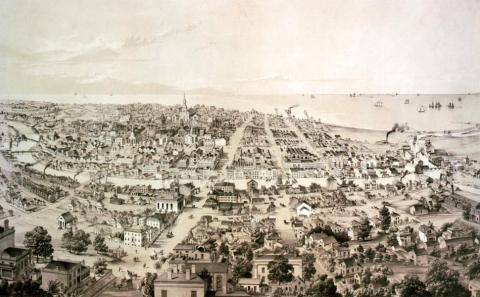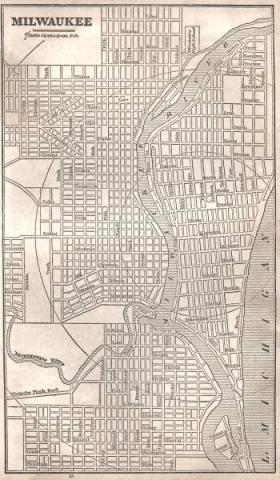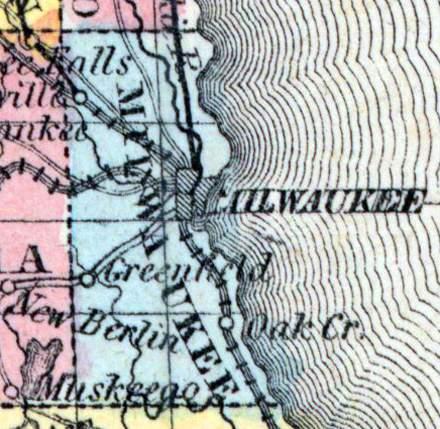MILWAUKEE, the chief city of Wisconsin, and next to Chicago, the largest on Lake Michigan, is situated in Milwaukee co., finely located for commerce, on both sides of Milwaukee river, at its entrance into the lake... Steamboats and other vessels, navigating Lake Michigan, touch here, on their way to and from Detroit and points on Lake Erie, and the St. Lawrence, Erie, and Welland canals. The surrounding region is rich, and rapidly increasing In an industrious and enterprising population, of which Milwaukee is the nucleus and the centre of trade. (Fanning's, 1853)
MILWAUKEE, City, the county seat of Milwaukee county, and the largest town in the State, is situated in town 7, of range 22, E., and near the mouth of the river of the same name, and on the shores of a bay, or indentation of Lake Michigan, some six miles between the outer points, and two and one half to three miles .in width, affording deep water at all times, and good holding ground for vessels at anchor. The river comes from the north in a direction parallel with the lake shore, the land rising from the lake in almost perpendicular bluffs, and descending gradually to the bed of the river. On the west, the land rises again to a considerable height. Within the limits of the corporation, the Menominee river comes in from the west, and joins the Milwaukee, about a mile from its present month. Piers were erected some years since by the United States Government, at the mouth of the river; but the citizens have long felt the necessity of dispensing with the circuitous route which the river takes through the low grounds near its mouth, and have projected a cut through an isthmus of some 200 feet in width between the river and lake, and the erection of piers at that point, thus forming a new harbor or opening into the river. There is always water enough in the river for the largest class of lake craft, as far up as the mills, some two miles from its mouth. Recently, (May, 1853,) the citizens have voted a loan, of $50,000, to be expended in connection with a Government appropriation of $15,000, in the improvement of the harbor. Milwaukee was laid out as a village in 1835. Its rapidity of growth may be seen from the following, giving the population for the years mentioned: In 1838, 700; 1840, 1,751;, 1842, 2,700; 1846, 9,655; 1847, 14,061; 1849, 18,000; 1850, 20,061. The above presents a rate of increase unparalleled in the history even of the rapidly growing West. At present, the population is estimated at over 25,000 souls. A dam is thrown across the Milwaukee river, near the north limits of the city, and a canal is conducted from it parallel with the stream, affording an abundant water power; the present capacity of which may be increased at comparatively small expense. Five large flouring mills, one woollen factory, oil mill, pail factory, and numerous machine shops, are situated upon this water power, and are accessible to vessels of the largest class. The town of Milwaukee was incorporated as.a city by the territorial Legislature, January 31, 1846, with five wards; and the first election under the charter was held on the first Tuesday of April succeeding. Solomon Juneau, who, as an Indian trader, had first built his cabin on the site of the city, and remained for many years the only white settler, was chosen the first mayor. The number of buildings erected in 1850 was 325, at a cost of $369,000. Since that time the city has greatly enlarged its borders, and increased in the number and quality of its buildings. The color of the brick used being a light cream, with their excellent quality, add very much to the appearance of the city. Great taste is exhibited in the architecture of many of the dwellings and blocks of stores; some of the latter rivalling any buildings of the kind west of New York. Seven daily newspapers, four in English and three in German, are published in the city. All of these publish weekly editions, and most of them tri-weeklies. There are, besides, two other weeklies, and two monthly publications issued. The public schools of this city are under the charge of a board of three commissioners from each ward. A commodious brick edifice has been erected in each ward for the purpose, at an average cost of about $5,000. A large portion of the children of the city receive gratuitous instruction in these schools. Besides these, there are numerous private academies and schools, among which may be mentioned the Milwaukee University Institute, which is incorporated with a University charter—the Milwaukee Female College, for which a very tasteful and extensive brick building has been erected—the Spring street Female Seminary—the Milwaukee Commercial and English School—the Milwaukee Academy, &c. For the last mentioned, a commodious brick building is erected and in use. There are in Milwaukee 35 church organizations, and nearly 30 church edifices. In 1852 there were 29 organizations, of the following denominations: 2 Baptist, 2 Congregational, 4 Roman Catholic, 3 Protestant Episcopal, 1 Norwegian Lutheran, 6 German Protestant, 3 Methodist Episcopal, 5 Presbyterian, 1 Universalist, and 2 Wesleyan Methodist. Among the associations for various objects and .purposes, there were last year in operation a City Bible Society, Tract Society, 2 Musical Societies, 3 Orphan Asylums, 2 Benevolent Societies, several Literary Associations, 5 Odd .Fellows' Lodges, 3 Masonic Lodges, 2 Temperance Divisions, besides numerous Insurance and other Companies, belonging more appropriately to business matters. Eight Fire Companies constitute that department, well supplied with the necessary machines, ;and it is conducted with efficiency and harmony. The city is lighted with gas, supplied from extensive works erected in 1852. The United States District Court holds its sessions in this city. The Circuit and County Courts also hold several terms during the year; and a Municipal Court will probably be soon established. Several consulships for German States are located in Milwaukee, for the benefit of the very large number of Germans who arrive at Milwaukee and other Wisconsin ports, and settle within the State. During the past three years, much has been done to increase the facilities of intercourse between Milwaukee and the interior of the State. Several plank roads stretch out in various directions, there being now near 200 miles constructed and in operation. The Milwaukee and Mississippi rail road is completed as far as Janesville, 71 miles, and is under contract from Milton, 8 miles northeast from Janesville to Madison, to be completed by the 1st January, 1854, whence it is to run westward to Prairie du Chien, on the Mississippi, at the mouth of the Wisconsin. Other roads are chartered, and portions of them contracted, or ready for contract, as follows: Green Bay, Milwaukee and Chicago, running north and south. The portion of this road, south of Milwaukee, is expected to be complete within 18 months.—Milwaukee and Beloit, (chartered;) about 70 miles in length, but the connexion can be made through other roads in half that distance.—Milwaukee and Watertown, under contract to Watertown, 46 miles north of west, to be extended to Portage city immediately, and thence to La Crosse on the Upper Mississippi.—La Crosse and Milwaukee, nearly in the same direction as the last named, passing through Dodge county. A large amount of stock subscribed, and the enterprize in energetic hands.—Milwaukee, Fond du Lac and Green Bay, fully organized by the subscription of stock, and with a prospect of early completion. These several lines of railway, once completed, will make Milwaukee the business centre of a very rich and rapidly growing region of country. Measures are now prosecuted with energy for the building of a railroad across the State of Michigan, which, in connexion with the Canadian system of roads, will place Milwaukee on almost an air line route from the northwest to the great Eastern cities. The value of articles manufactured in the city in the year 1852, was over $2,000,000. Tonnage of vessels owned in the city, 8,548. Number of arrivals at the port in 1852, about 1600; and departures the same. Of principal articles, the following quantities were exported during the year 1852, viz: flour, 88,597 bbls.; wheat, 394,386 bushels; barley, 345,620 bushels; oats, 428,800 bushels; rye, 67,759 bushels; hogs, live and dressed, 1,771,314 lbs.; pork, 19,603 bbls.; bacon, 188,286 lbs.; beef, 7,773 bbls.; eggs, 54,000 doz.; butter, 80,000 lbs.; saleratus, 150,000 lbs.; mill feed, 300 tons; hops, 11,625 lbs.; brick, 700,000; wool, 321,121 lbs.; hides, 12,990 lbs.; flax, 4,211 lbs.; broom corn, 270 tons; ashes, pot and pearl, 3,291 casks; grass seed, 5,852 bbls.; furs, 139 bales; lead and shot, about 1,000,000 lbs.; staves, dressed, 189,000, &c. &c. (John Warren Hunt, Wisconsin Gazetteer..., Madison, 1853)



